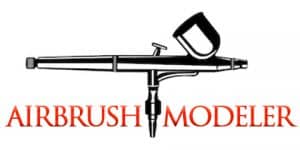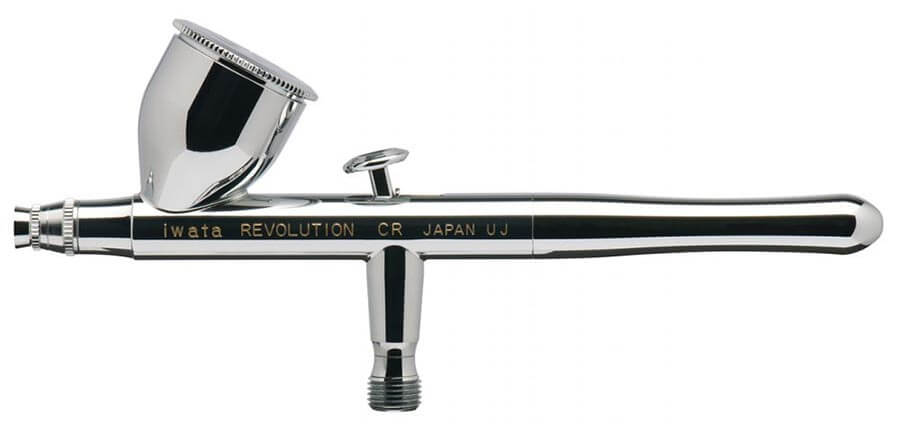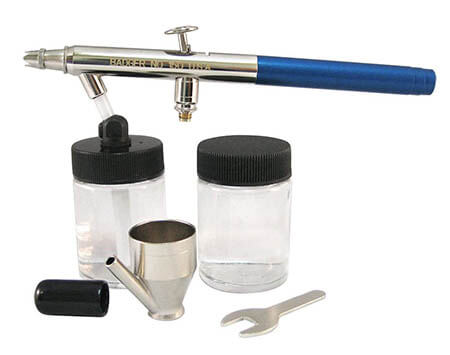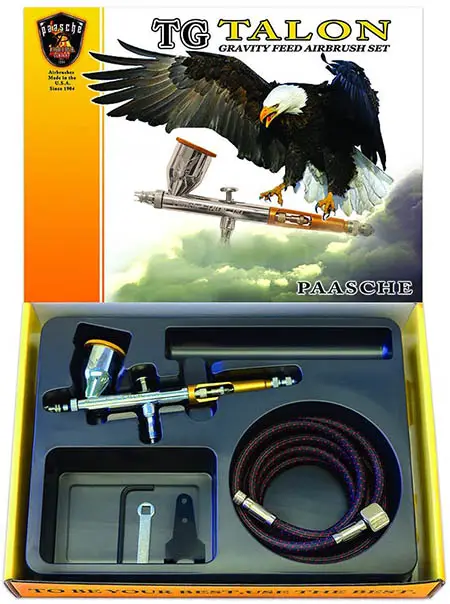What Is The Difference Between A Single Action And double Action Airbrush
The difference between a single action and double action airbrush comes down to the functionality of the trigger mechanism and whether it allows you to deliver a fixed or variable amount of paint respectively.
A single action airbrush delivers a fixed amount of spray paint when the trigger is pressed, whereas the double action airbrush delivers air when the trigger is pressed down, and a varying amount of paint depending on how far the trigger is pulled back in a second motion.
The commonality between the two is that when the trigger is pressed down the air flows at whatever pressure is set at your air compressor, but what each type of airbrush then does with the paint differs.
Let’s take a look at each to get a better understanding of what’s going on…
How Does A Single Action Airbrush Work
A single action airbrush is labelled as such due to the single movement capability of the trigger, in that it can only be pressed down and this will provide a fixed amount of paint. It essentially works exactly like a can of spray paint does.
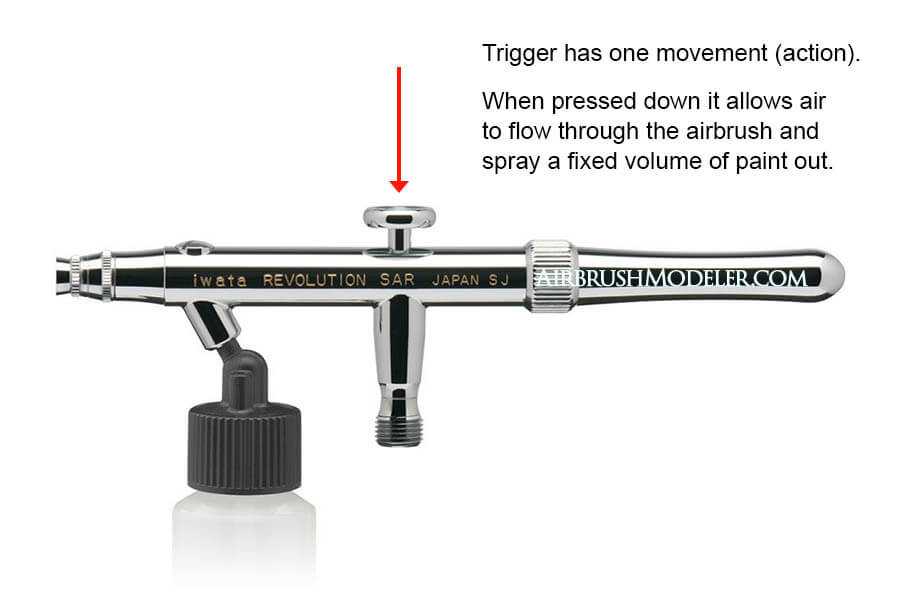
On a single action airbrush the amount of paint that sprays can be controlled, but rather than this be dictated by the trigger it is altered by turning a part of the airbrush that adjusts the opening of the nozzle so that more paint can flow through, or vice-versa.
Exactly what has to be adjusted to get a different amount of paint to flow differs between different brands of airbrush, whether they are siphon feed or gravity feed, and whether they are internal mix or external mix.
The instructions for each single action airbrush will be very clear on exactly how to adjust the paint flow.
See the table below for examples of single action airbrushes from reputable brands…
Double Action Airbrush Model | Reviews & Current Prices | |
Iwata Revolution HP-CR Gravity Feed Dual Action Airbrush | ||
Badger 150 Siphon Feed Double Action Airbrush | ||
Paasche TG-SET Gravity Feed Double Action Airbrush | ||
How Does A Double Action Airbrush Work
A double action airbrush is labelled as such due to the double, or dual, movement capability of the trigger, in that pressing down on the trigger delivers air and pulling back on the trigger will deliver successively more paint as the trigger moves backwards.
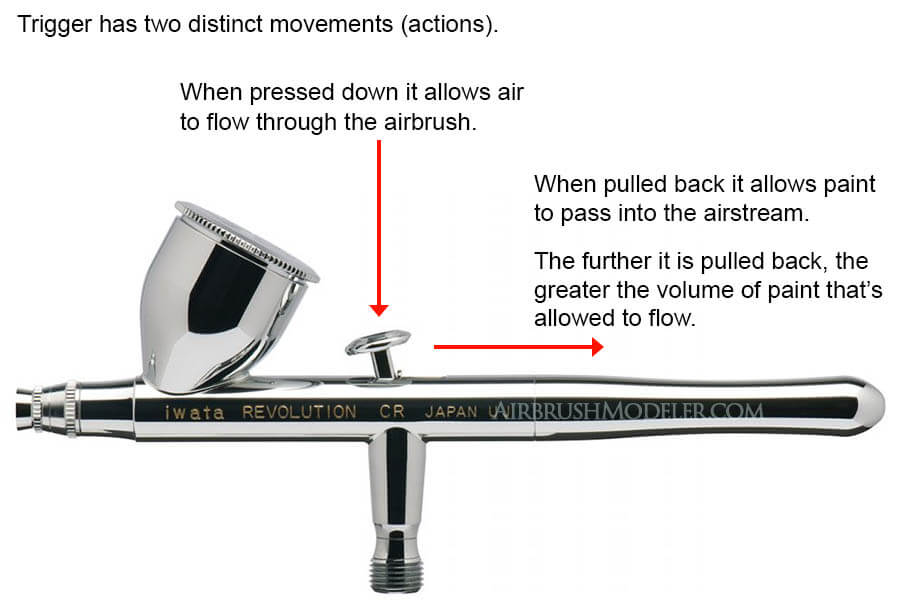
The further you pull the trigger back on a double action airbrush the more paint comes out, allowing for greater control especially during detail painting where you may want more or less paint on the fly.
See the table below for examples of single action airbrushes from reputable brands…
Single Action Airbrush Model | Reviews & Current Prices | |
Paasche Airbrush H-Set Single Action Siphon Feed Airbrush Set | ||
Badger 200NH Single Action Siphon Feed Airbrush Set | ||
What Is Better A Single Action Or Double Action Airbrush
A double action airbrush has a greater learning curve, but is generally considered to be the superior option as it gives you immediate control over the amount of paint being delivered during airbrushing which can give great flexibility during painting, especially when it comes to detail painting and airbrushing scale models and the like.
Let’s take a more detailed look at how different airbrushing tasks will lend themselves better to either the single action or double action airbrush…
Painting Large Areas Of A Single Colour
Single action airbrushes are excellent for getting very consistent paint coverage over large areas with the constant paint flow and spray pattern giving a very even finish.
With s double action airbrush this is certainly also possible, however with full user control over the amount of paint flowing any inconsistent pressure on the trigger can cause different amounts of paint to go down on different parts of the job, causing streaking or blotchiness.
WINNER: Both
Detail Airbrushing
Detail airbrushing is very much enhanced by the ability to regulate the amount of paint getting to the job.
A single action airbrush can certain achieve fine details lines, but fine detail work often has a freestyle element to it where the same line thickness is not always desired.
Where this is the case the double action airbrush comes into its own where changing the volume of paint spraying can give subtle changes in the thickness of the lines being painted, leading to a better and more professional job.
WINNER: Double Action
Freestyle Airbrushing
This was touched on in the last point, in that various airbrushing tasks require different amounts of paint during the spraying session of any given colour.
This may be detail work, or larger scale work where an effect such as fading is desired.
With the double action airbrush regulating the amount of paint flowing various artistic effects become much easier to achieve than when using a single action airbrush.
WINNER: Double Action
Airbrushing Models And Other Unusual Shapes
A scale model, for example, can have very unusual shapes to paint, such as an aircraft fuselage and wings, or the many curves on a motor vehicle, and having a fixed paint volume is not always ideal.
Some areas of the part will be expansive and flat and can handle a lot of paint at once, and this is fine for a single action airbrush.
Whereas there might also be some little nooks on the model (or whatever item it is that you’re airbrushing) that require the same colour but in a lower volume so as to avoid
WINNER: Double Action
Reflow Of Paint
It’s a fairly common occurrence, at least when airbrushing scale model parts, to put the airbrush down for a small amount of time between mist coats and wet coats.
During this time the paint in the paint tubes and around the nozzle and needle tip can dry causing a slight blockage.
This problem may require cleaning on a single action airbrush, or at the very least you’ll need to crank up the air pressure and give the airbrush a blast to clear the dried paint out so you can get proper flow again (hence the term I coined, reflow).
With a double action airbrush however, I find that I seldom use the full capacity of paint flow with most of my airbrushing.
So when I come back to the airbrush after short break I simply leave the air pressure as is, and spray the airbrush once with the trigger completely open so that the nozzle is fully open, and let the big blast of paint push out any small blockages.
It’s almost the same in both single and double action airbrushes, it’s just quicker in double action airbrush and doesn’t usually require fiddling around with the compressor to alter the air pressure.
WINNER: Double Action
Learning Curve
There’s no doubt that the single action airbrush with is less complicated trigger has a much easier learning curve.
That’s not to say that a double action airbrush is out of reach for people new to airbrushing at all, it may just take a little longer to get really competent as using a double action airbrush.
WINNER: Single Action
What Is The Best Airbrush Type For A Beginner
The best type of airbrush for a beginner is a double action airbrush in all instances except for two:
- You are intimidated by the learning curve of a double action airbrush and want a simpler airbrush overall;
- The cost of a double action airbrush is prohibitive;
From the points in the last section it would seem that the double action airbrush should win hands down, unless of course you’re a little intimidated by the complexity and learning curve of a double action airbrush.
But this is not necessarily the case, and there are many excellent single action airbrushes on the market which are more than capable of giving you an excellent paintwork result, including when airbrushing scale models as I do.
Let’s go over the points for and against each type of airbrush…
A beginner should start with a single action airbrush for the following reasons:
| Reason | Explanation On Why |
| Simplicity | Less moving parts and only having to press the trigger down to get paint without any further manipulation, means you’ll master that particular airbrush quicker. Plus there’s potentially easier trouble shooting with less moving parts should you encounter a problem. |
| Slightly Lower Cost | With less complexity overall, single action airbrushes, on average, will be slightly easier on the wallet than double action airbrushes. |
A beginner should start with a double action airbrush for the following reasons:
| Reason | Explanation On Why |
| Greater Detail Capability | The ability to manipulate the amount of paint flowing on the fly gives the user the opportunity to create much more finely detailed paint work. |
| Freestyle Airbrushing | If you need a fade or paint effect of some kind, having control over the amount of paint flowing by using a double action airbrush will give you a significant advantage. |
| Use On Unusual Shapes | If you’re not always painting on flat surfaces then being able to alter the paint volume being sprayed on the fly should give better results with less potential issues. That is, small nooks don’t require the same amount of paint as a large open space, for example, on a scale model car body. |
Final Thoughts On Single Action Vs Double Action Airbrushes
A single action airbrush can do everything a double action airbrush can do but without the same degree of finesse and detail.
On the flip side, a double action airbrush can do everything a single action airbrush can do, and more, but the learning curve is a little steeper and the double action airbrush may cost a little more.
Personally, my recommendation is that if you can afford a double action airbrush, which shouldn’t be significantly more than a single action airbrush, to go straight for the double action airbrush and meet the slightly greater learning curve head on.
The learning curve is certainly not insurmountable by a beginner and in many forums and online groups the learning curve of a double action airbrush is perhaps blown out of proportion.
Additionally, a single action airbrush will be satisfactory, if not perfect, for most applications, however eventually we all want to improve our skills and paint work and will look to upgrade to a double action airbrush for the added flexibility it offers.
Given that airbrushes are a moderately expensive investment, and that you’ll likely have your airbrush for quite some years assuming you buy a reputable brand, my strong belief is that it’s worth going straight to a double action airbrush from the get-go. 👍
